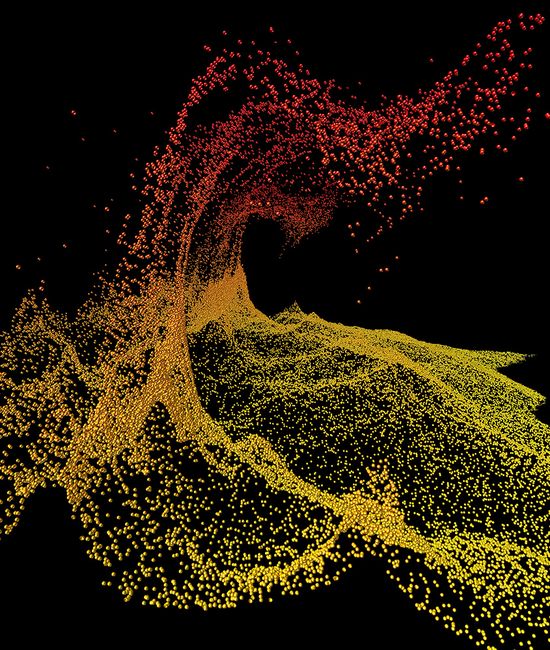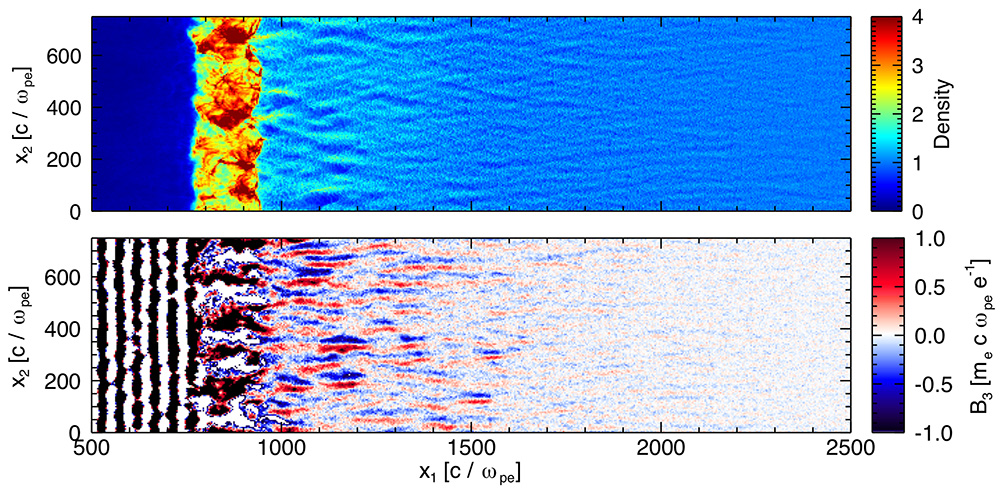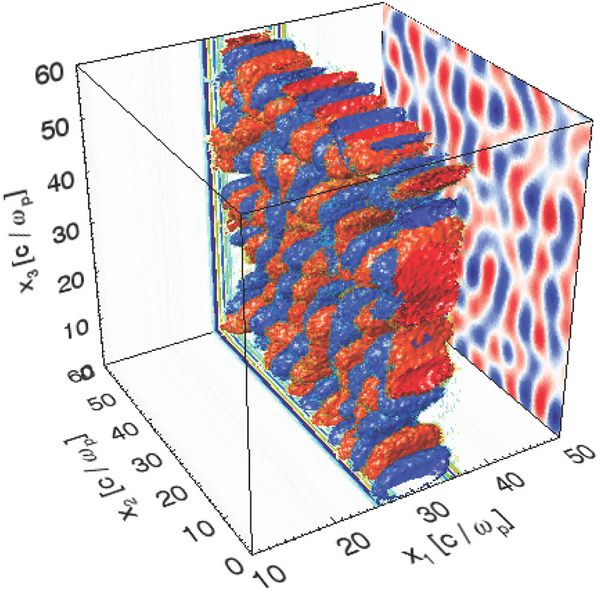ASTROPHYSICS
Shock Acceleration in the Laboratory with Ultraintense Lasers
Principal Investigator:
Luís O. Silva
Affiliation:
GoLP/Instituto de Plasmas e Fusão Nuclear, Lisboa (Portugal)
Local Project ID:
PRA_2015
HPC Platform used:
JUQUEEN of JSC
Date published:
A team of researchers has performed the largest simulations of unmagnetised shocks driven in astrophysical conditions to determine the parameters required to excite shocks in the laboratory, and studied the set of complex and nonlinear phenomena involved in these scenarios, such as magnetic field generation and particle acceleration.
The most energetic particles in the Universe are cosmic rays which are thought to be accelerated in collisionless shocks driven by outflows of plasma moving in different astrophysical contexts. What is the origin of cosmic rays? What are the dominant acceleration mechanisms in relativistic shocks? How are shocks generated and how can they be reproduced in the laboratory and then be used to accelerate ions for proton therapy. These are longstanding scientific questions, closely tied to extreme plasma physics processes. The underlying physics is highly nonlinear and intrinsically kinetic nature i.e. requiring the description of the individual motion of charged particles.

Figure 1: Ion acceleration from a strong electrostatic shock wave driven by intense laser-plasma interactions. The spheres colored by energy (yellow – red) represent the ions that are reflected from the background by the fast moving shock wave. -- This work was published in D. Haberberger et al., Nature Physics Nature Physics 8, 95 (2012); and F. Fiuza et al., Physical Review Letters 109, 215001 (2012).
Copyright: Instituto Superior Tecnico, Lisbon, PortugalReproducing these conditions in silico is a grand computational challenge, due to the large number of particles that one must follow to capture these nonlinear waves. Under this project, a team of researchers led by Prof. Luis O. Silva, from Instituto Superior Tecnico, Lisbon, Portugal, in collaboration with researchers at the University of California Los Angeles (USA) and at the Rutherford Appleton Laboratory in the UK, has performed the largest simulations of unmagnetised shocks driven in astrophysical conditions to determine the parameters required to excite shocks in the laboratory, and studied the set of complex and nonlinear phenomena involved in these scenarios, such as magnetic field generation and particle acceleration. The simulations have been performed with the state-of-the-art particle-in-cell code OSIRIS. HPC system JUQUEEN of Jülich Supercomputing Centre served as computing platform for this project.
The results have been transformative by identifying parameter regimes of relevance for multi-PW (Petawatts) lasers coming online very soon, such as those in the ESFRI roadmap as the Extreme Light Infrastructure, but also by demonstrating that these shocks can accelerate protons to energies close to 200 MeV (million electron volts), thus providing an exciting path towards producing more efficient and economic particle sources for proton therapy. These results have triggered a strong experimental effort in exploring this new avenue for proton acceleration with a large number of teams now pursuing these ideas, developing new targets and performing new experiments to explore this new acceleration mechanism.
The generation of these high-quality 200 MeV proton beams in such a compact system could have a great impact in medical applications such as the treatment of deep-seated tumors. From a more fundamental perspective the results of this project have also provided a critical and unified understanding of the nature of the shocks and the structure of the associated self-consistent fields in both astrophysical and laboratory scenarios.
This work was performed in the framework of the ERC Advanced Grant Accelerates. Computing time for this project was granted through the Partnership for Advanced Computing in Europe (PRACE). On HPC system JUQUEEN of Jülich Supercomputing Centre.

Figure 2: Structure of Weibel-mediated shock driven by the interaction of an intense laser with an overcritical target. The top panel shows the density compression behind the shock and the filamentary structure ahead of it. The bottom panel shows the strong filamentary magnetic fields associated with the Weibel instability. -- This work was published in F. Fiuza et al., Physical Review Letters 108, 235004 (2012).
Copyright: Instituto Superior Tecnico, Lisbon, Portugal
Figure 3: Perpendicular electromagnetic field in the course of shock formation. 2D projections show the electrostatic field in the planes parallel to shock propagation and the magnetic field projection in the perpendicular plane. -- This work was published in A. Stockem et al., Physical Review Letters 113, 105002 (2014).
Copyright: Instituto Superior Tecnico, Lisbon, PortugalScientific Contact:
Luís O. Silva
GoLP/Instituto de Plasmas e Fusão Nuclear
Complexo Interdisciplinar
Instituto Superior Técnico
1049-001 Lisboa/Portugal
e-mail: luis.silva@ist.utl.pt -- epp.tecnico.ulisboa.pt/los/